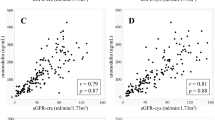Abstract
In a total of 428 urine samples collected from 15 patients aged between 23 and 60 years after cadaveric kidney transplantation during a postoperative hospital stay, Tamm-Horsfall protein (THP) was quantitatively determined using theELIAS SYNELISA-THP immunoassay. All patients were treated with azathioprine, cyclosporine, prednisolone, given an intraoperative high-dose single antilymphocyte globulin bolus and discharged with functioning grafts. In clinically uncomplicated courses, even after immediate transplant function, the recovery of graft function took on average 7 days. Thereafter the urinary THP excretion was relatively stable and amounted, on average, to 14.5 ± 4.9 mg/24 h (i.e. was at the lower limit of normal urinary THP excretion). In cases of delayed onset of graft function of undetermined origin accompanied by extremely reduced urinary THP excretion, the functional recovery, whether spontaneous or brought about by treatment, was characterized by a continuous increase in urinary THP excretion. In connection with interstitial rejections urinary THP excretion seems not to be a recommendable diagnostic parameter. Daily measurement of urinary THP is, however, suitable for monitoring the functional state of transplanted kidneys.
Similar content being viewed by others
References
Allen F, Tisher CC (1976) Morphology of the ascending thick limb of Henle. Kidney Int 9:8
Avis PJG, Williams JD, Salaman JR, Asscher AW, Newcombe N (1985) Serum Tamm-Horsfall protein (THP) concentration in cyclosporin treated renal transplant recipients. Lancet II:154
Bernard AM, Ouled AA, Lauwerys RR, Lambert A, Vandeleene B (1987) Pronounced decrease of Tamm-Horsfall proteinuria in diabetics. Clin Chem 33:1264
Cohen AH, Border WA, Rajfer J, Glassock RJ (1984) Interstitial Tamm-Horsfall protein in rejecting renal allografts. Lab Invest 50:519
Eichler C, Kaden J, Strobelt V, Oesterwitz H, Scholz D (1989) Cytomegalievirusnachweis mittels monoklonaler Antikörper an Aspirationsmaterial von Nierentransplantaten. Z Urol Nephrol 82:13
Grant AMS, Baker LRI, Neuberger A (1973) Urinary Tamm-Horsfall glycoprotein in certain kidney diseases and its content in renal and bladder calculi. Clin Sci 44:377
Grover PK, Ryall RL, Marshall VR (1990) Does Tamm-Horsfall mucoprotein inhibit or promote calcium oxalate crystallization in human urine? Clin Chim Acta 190:223
Hartmann L, Bringuier AF, Chopin N, Kechrid C, Fries D (1985) Role of serum and urinary Tamm-Horsfall protein in the surveillance of kidney transplants. CR Soc Biol Paris 179:452
Hession C, Decker JM, Sherblom AP, Kumar S, Yue CC, Mattaliano RJ, Tizard R, Kawashima E, Schmeissner U, Heletky S, Chow EP, Burne CA, Shaw A, Muchmore AV (1987) Uromodulin (Tamm-Horsfall glycoprotein): a renal ligand for lymphokines. Science 237:1479
Howie AJ, Brewer DB (1983) Extra-tubular deposits of Tamm-Horsfall protein in renal allografts. J Pathol 139:193
Kaden J, May G, Schönemann C, Müller P, Groth J, Seeger W, Seibt F, Henkert M, Lippert J (1992) Effect of ATG prophylaxis in sensitized and non-sensitized kidney graft recipients. Transplant Int 5 [Suppl 1]:75
Kaden J, May G, Weßlau C, Müller P, Henkert M, Groth J (1992) Reduktion der OKT 3-induzierten Zytokinfreisetzung in Abhängigkeit von der Prednisolondosis. TxMed 4:130
Kaissling B, Peters S, Kriz W (1977) The transition of the thick ascending limb of Henle's loop into the distal convoluted tubule in the nephron of the rat kidney. Cell Tissue Res 182:111
Kumar S, Muchmore A (1990) Tamm-Horsfall protein-uromodulin (1950–1990). Kidney Int 37:1395
Muchmore A, Decker JM (1985) Uromodulin: a unique 85 kilodalton immunosuppressive glycoprotein isolated from urine of pregnant women. Science 229:479
Pennica D, Kohr WJ, Kuang WJ, Glaister D, Aggarwal BB, Chen EY, Goeddel DV (1987) Identification of human uromodulin as the Tamm Horsfall urinary glycoprotein. Science 236:83
Rath W, Neßelhut T, Grospietsch G, Stadler H, Weber MH, Otto V, Kuhn W (1988) Veranderungen des Urinproteinmusters in der SDS-polyacrylamidgelelektrophorese (SDS-PAGE) bei normalen und hypertensiven Schwangerschaften. Geburtshilfe Frauenheilkd 48:724
Reinhart HH, Obedeanu N, Sobel JD (1990) Quantitation of Tamm-Horsfall protein binding to uropathogenicEscherichia coli and lectins. J Infect Dis 162:1335
Reinhart HH, Obedeanu N, Robinson R, Korzeniowski O, Kaye D, Sobel JD (1991) Urinary excretion of Tamm-Horsfall protein in elderly women. J Urol 146:806
Ryall RL, Harnett RM, Hibberd CM, Edyvane KA, Marshall VR (1991) Effects of chondroitin sulphate, human serum albumin and Tamm-Horsfall mucoprotein on calcium oxalate crystallization in undiluted human urine. Urol Res 19:181
Schumann V, Claus M, Fritschka E, Wagner K, Phillipp T (1992) Tamm-Horsfall-Protein als Funktionsparameter bei Nierentransplantationen. (abstract) 23rd Congress of the Gesellschaft für Nephrologie, Hanover
Sherblom A, Decker J, Muchmore A (1988) The lectin-like interaction between recombinant tumor necrosis factor and uromodulin. J Biol Chem 263:5418
Tamm I, Horsfall FL (1950) Characterisation and separation of an inhibitor of viral hemagglutination present in urine. Proc Soc Exp Biol Med 74:108
Zimmerhackl LB, Weber G, Höfer D, Fabricius T, Drenckhahn D, Scott DM, Kinne R, Brandis M (1989) Excretion of the renal antigens villin and Tamm-Horsfall protein as indicator of regional tubular cell regeneration after renal transplantation. (abstract 32) Eur J Ped 148:484
Zimmerhackl LB, Pfleiderer S, Kinne R, Manz F, Schuler G, Brandis M (1991) Tamm-Horsfall protein excretion as a marker of ascending limb transport indicates early renal tubular damage in diabetes mellitus type I. J Diabetes Complications 5:112
Author information
Authors and Affiliations
Rights and permissions
About this article
Cite this article
Kaden, J., Groth, J., May, G. et al. Urinary tamm-horsfall protein as a marker of renal transplant function. Urol. Res. 22, 131–136 (1994). https://doi.org/10.1007/BF00571838
Received:
Accepted:
Issue Date:
DOI: https://doi.org/10.1007/BF00571838




